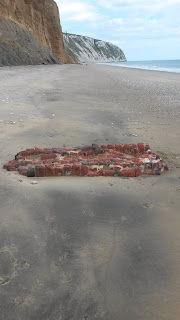woolf and sackville-west
Last week, in the company of dear friends, I was lucky enough to visit two beautiful English gardens, blooming in the June sunshine. Luckier still these gardens were attached to two different, very slightly 'stately', homes, once owned by two wonderful women writers.
The first was Monk's House, in Sussex. A 17th century retreat, once owned by Virginia Woolf and her husband Leonard. The few rooms in the house that we were allowed to walk through were gloomy, and atmospheric, and fascinating. But the room of real interest was Virginia's writing room. It was in a large summer house, set apart from the main house, further down the garden, amongst fruit trees and cottage garden borders. Unfortunately visitors weren't allowed to enter the room, but could gaze into it through large windows set in three sides of the building. The room was full of items that had once belonged to Virginia, and were arranged around the room, and on the desk, as if the room was still in use and the owner had just stepped outside to to sit in the cool shade by the pond. The information board outside the writing room suggested that Virginia had written A Room of One's Own, her 1929 book length essay, inside this very writing room.
The day after visiting Monk's House, I visited Vita Sackville-West's home, Sissinghurst, which Vita shared with her husband Harold Nicholson. Situated in Kent, this property is much more 'stately' than Monk's House, and includes a very large manor house - parts of which date back to the 1530s - a tower which affords amazing views of the estate (you can climb the 79 steps to the parapet), and the many and varied walled gardens, surrounding the house, first designed and planted by Vita and Harold. Approximately half way up the tower stairs is Vita's writing room/library. Like Virginia's room, the public are not allowed into this room but can view it through the curlicued iron gate that bars the entrance. Also like Virginia's room, Vita's is full of ephemera. Her desk, the tables and chairs are covered with books, old documents, and other items, and gives the impression that Vita just popped downstairs for a walk in the grounds while you're sneaking a look into the room.
Virginia Woolf (1882-1941) and Vita Sackville-West (1892-19620) were both essayists and novelists, and both clearly valued having a room of their own in which to spend time dedicated to their writing. Vita was also a very keen gardener, indeed she wrote a gardening column for the Observer newspaper for 15 years, whilst Virgina was happy to let Leonard design the gardens at Monk's House.
The two women met at a dinner party in 1922, and became lovers, for a decade, and remained friends until the end of Virginia's life. Virginia was instrumental in setting up the Bloomsbury Group - an influential group of artists and writers. Vita became a central figure in that group and was something of a muse for Virginia. It's rumoured she served as inspiration for the protagonist of Virginia's 1928 novel Orlando.
I highly recommend a visit to both Monk's House, and Sissinghurst, if you're ever in the vicinity of either. The gardens alone are worth the entry price, but those two writing rooms are very special too. Both properties are run by the National Trust.
Vita Sackville-West's writing room at Sissinghurst (apologies it's a little out of focus)
Both photos are this blog author's own.



Comments
Post a Comment